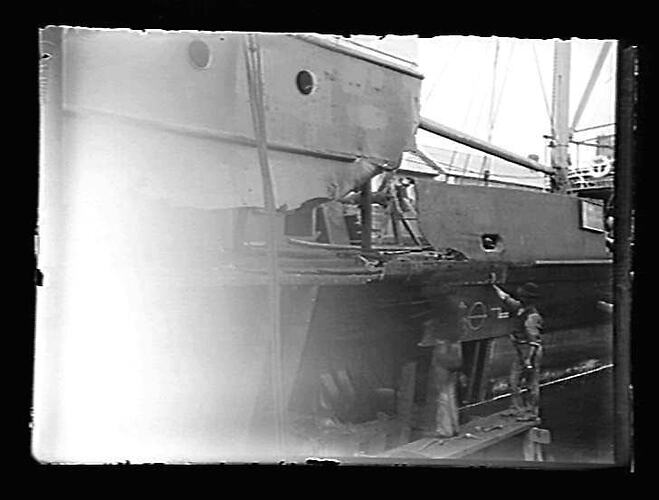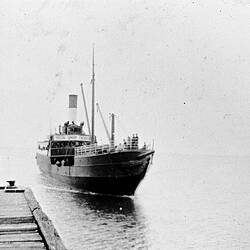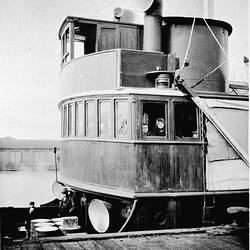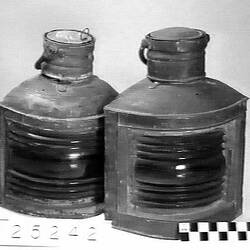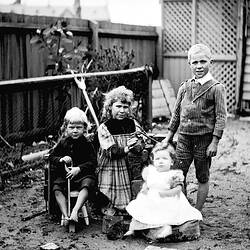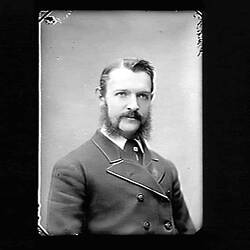Summary
The steamer 'Edina' in Duke and Orr's dry dock undergoing repairs, Melbourne, 3 May 1898. The 'Edina' was built in 1854 and was the oldest working steamship in the world when it was retired in 1938.
Photograph by Thomas Beckett. Part of a collection of glass plate negatives taken by Dr Thomas George Beckett, doctor, pioneering radiologist and amateur photographer between 1891 and 1910. The collection is primarily of Beckett's family, friends, homes, and towns and suburbs where Beckett and his family lived, including Charlton in central Victoria and Northcote & South Yarra, suburbs of Melbourne, Victoria.
At the time this photogeraph was taken, the 'Edina' was undergoing repairs to damage caused as a result of a collision with the Union Steamship Company's 'Manawatu' which occurred on the evening of 27th April 1898 near the Gellibrand Lightship, off Williamstown. As a result of the accident, the smaller wooden-hulled 122 ton 'Manawatu', outward bound for Devonport with a cargo of 1,000 bags of phosphates, sunk about 100 yards off Breakwater Pier, while the larger iron-hulled 'Edina', that was inward bound heading from Geelong to Melbourne, was deliberately run ashore near Point Gellibrand reef, where the vessel stuck vast for several days before being recovered. A subsequent Court of Marine Inquiry hearing in May acquitted the pilot Blanchard on a charge of misconduct, but found Captain Forbes of the 'Edina' guilty of gross misconduct and suspended his certificate for 12 months.
The extensive damage to the 'Edina' (which can be clearly seen in this photo), was described in the press as follows: 'On the starboard side, immediately forward of the bridge, the line of the bulwarks show a curve 'inwards," and 6ft. further, on the gradually increasing turn ends abruptly in a jagged edge of iron. For another 10ft, the whole side of the vessel above the water-line has been swept away, the cause being manifest by the presence of the complete half of a ship's bows bearing the word "Manawatu," in large white letters. Behind this piece of timber is one of the heavy iron anchors of the Tasmanian boat, and scattered among the debris is a quantity of its other tackle. The spot where the nose of the Manawatu now lies amid a heap of shattered timber and iron was the cabin of the chief engineer, Mr Nolan, and above, the debris there still swings floral almanac, with the words "God Bless Our Home" shining out in gilt letters. But the worst damage of all was done the lower deck, for on gazing with difficulty over the starboard side a hole is to be seen "big enough," as the chief steward remarked "to drive a carriage pair through." This was the side of the saloon which smashed in, and the whole of the furnishings in that part are wrecked and torn.' (Williamstown Chronicle, 30 April 1898).
Description of Content
A view of damage to the starboard side of the hull of the steamship 'Edina', while in dry dock for repairs.
More Information
-
Collection Names
-
Collecting Areas
-
Acquisition Information
Donation from Mrs Joan Hadden, by Sep 1990
-
Place & Date Depicted
South Melbourne, Greater Melbourne, Victoria, Australia, 03 May 1898
-
Photographer
Dr Thomas George Beckett, 180 High Street, Northcote, Greater Melbourne, Victoria, Australia, 03 May 1898
-
Ship Depicted
SS Edina (Steamship), Wm. Howard Smith & Sons Ltd, Port Phillip Bay, Victoria, Australia
-
Format
Glass Negative, Black & White
-
Classification
-
Category
-
Discipline
-
Type of item
-
References
Williamstown Chronicle, 30 April 1898, p.3, 'Collision In The Bay Between Two Steamers, Edina And Manawatu. Inward And Outward Bound. No Lives Lost.', [Link 1] viewed 06/01/2014; Chronicle (Adelaide), 30 April 1898, p.27, 'A Serious Collision. The Manawatu Sinks. Edina Runs Ashore. Passengers And Crews Safe.', [Link 2] viewed 06/01/2014; The West Australian, 18 May 1898, p.5, [Link 3] viewed 06/01/2014.
-
Keywords
Dry Docks, Marine Transport, Paddle Steamers, Shipping, Water Transport
